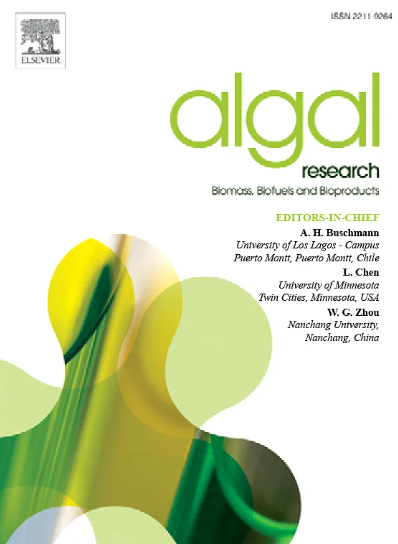newestiellopsis sp.菌株VKB03释放高分子物质的生化、热及功能表征
IF 4.6
2区 生物学
Q1 BIOTECHNOLOGY & APPLIED MICROBIOLOGY
Algal Research-Biomass Biofuels and Bioproducts
Pub Date : 2025-05-26
DOI:10.1016/j.algal.2025.104114
引用次数: 0
摘要
合成聚合物在工业上广泛应用于塑料成型、食品添加剂、药物聚合物和开发化妆品配方。然而,合成聚合物的不可生物降解性已经造成了重大的、不可逆转的生态负面影响。在过去的几十年里,对环保和生物基产品的需求大幅增加。在发现天然聚合物的边缘,蓝藻释放的聚合物在保护自然中发挥着有希望的作用。在本研究中,我们从newestiellopsis sp.菌株VKB03中提取了释放的高分子物质(RPSs)。rps的生化分析显示碳水化合物、蛋白质和DNA的存在,并获得了无机和有机取代基。RPSs表现出优异的功能、热性能和抗氧化性能。FT-IR数据显示存在多种官能团和糖苷键。实验结果表明,该材料具有良好的持水能力(1822.5±1.2%)、持油能力(144.0±0.6%)和水溶性指数(30±0.8%)。热重和差示扫描量热分析显示出优异的热稳定性。生物絮凝和乳化活性进一步证明了RPSs作为合成聚合物的替代品在许多商业建立的工业部门。在结构上,甘肽和圆二色性分析分别显示为o链糖基化和随机线圈构象。微观结构分析和x射线衍射分析分别揭示了RPSs的不规则形状和无定形性质。本研究的结果表明,蓝藻rps提供了一个有前途的方法,利用在工业部门的不同领域。本文章由计算机程序翻译,如有差异,请以英文原文为准。
Biochemical, thermal, and functional characterization of released polymeric substances of Neowestiellopsis sp. strain VKB03
Synthetic polymers are widely used in forming plastic, food additives, pharmacopolymers and developing cosmetic formulations in the industry. However, the non-biodegradable properties of synthetic polymers have resulted in significant and irreversible ecological negative impacts. Over the past few decades, there has been a significant surge in the demand for environmentally friendly and bio-based products. On the verge of finding natural polymers, cyanobacterial released polymers play a promising role in safeguarding nature. In the present study, we have extracted released polymeric substances (RPSs) from Neowestiellopsis sp. strain VKB03. The biochemical analyses of RPSs revealed the presence of carbohydrates, proteins, and DNA, garnered with both inorganic and organic substituents. RPSs showed excellent functional, thermal, and antioxidant properties. FT-IR data revealed the presence of various functional groups and glycosidic linkage. Experimental results showed a good water holding capacity (1822.5 ± 1.2 %), an oil holding capacity (144.0 ± 0.6 %), and water solubility index (30 ± 0.8 %). Thermal gravimetric and differential scanning calorimetry analyses have shown excellent thermostable properties. The bioflocculation and emulsifying activity further proves RPSs as an alternative for synthetic polymers in many commercially established industrial sectors. Structurally, glycan-peptide and circular dichroism analyses reveal o-linked glycosylation and random coil conformation respectively. Microstructure analysis and XRD pattern reveal the irregular shape and amorphous nature of RPSs respectively. The findings of this study indicate that cyanobacterial RPSs provides a promising approach for leveraging utilization in diverse domains of industrial sectors.
求助全文
通过发布文献求助,成功后即可免费获取论文全文。
去求助
来源期刊

Algal Research-Biomass Biofuels and Bioproducts
BIOTECHNOLOGY & APPLIED MICROBIOLOGY-
CiteScore
9.40
自引率
7.80%
发文量
332
期刊介绍:
Algal Research is an international phycology journal covering all areas of emerging technologies in algae biology, biomass production, cultivation, harvesting, extraction, bioproducts, biorefinery, engineering, and econometrics. Algae is defined to include cyanobacteria, microalgae, and protists and symbionts of interest in biotechnology. The journal publishes original research and reviews for the following scope: algal biology, including but not exclusive to: phylogeny, biodiversity, molecular traits, metabolic regulation, and genetic engineering, algal cultivation, e.g. phototrophic systems, heterotrophic systems, and mixotrophic systems, algal harvesting and extraction systems, biotechnology to convert algal biomass and components into biofuels and bioproducts, e.g., nutraceuticals, pharmaceuticals, animal feed, plastics, etc. algal products and their economic assessment
 求助内容:
求助内容: 应助结果提醒方式:
应助结果提醒方式:


